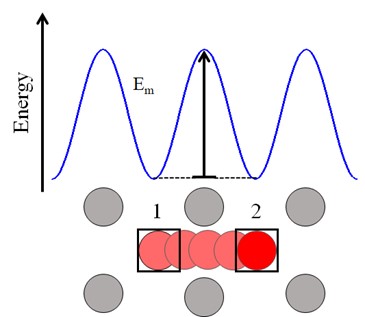Ion Migration Study on YAlO3-perovskite through Atomistic Simulations
DOI:
https://doi.org/10.29356/jmcs.v68i3.2047Keywords:
YAlO3 perovskite, atomistic simulations, point defect energy, ion migrationAbstract
Abstract. In this work, we presented an atomistic simulation study on YAlO3 perovskite. We simulated the reported crystal structure through the energy minimization process from coulombic and Buckingham potentials with the General Utility Lattice Program (GULP). We determined the formation energy for all point pair defects presented in the system. We found that the anionic Frenkel together with Schottky pair defects are the main defects in the YAlO3 perovskite.
Additionally, we performed several energy profile migrations for each ion, and we determined that oxygen migration was the favored migration via the vacancy-vacancy path with 98.70 kJ/mol. In the end, we performed a series of calculations about doping energy, and we calculated that Ca2+ is the best aliovalent ion for doping YAlO3 compound, which involves the minimum doping energy while the aliovalent doping increases the oxygen vacancy defects. We suggested that these atomistic simulations could be used as a tool in the design or optimization of new materials for developing solid electrolytes.
Resumen. En este trabajo presentamos un estudio hecho por medio de simulaciones atomísticas para el compuesto YAlO3 con estructura perovskita. La estructura se simuló por medio de la minimización energética de los potenciales de Coulomb y de Buckingham. Se determinó la energía de formación para todos los pares de defectos puntuales que puede presentar el sistema y encontramos que los defectos tipo Frenkel aniónico y los Schottky son los principales en el compuesto de estudio. También determinamos los perfiles energéticos de migración para los iones en el sistema y encontramos que la migración de menor energía corresponde a la de oxígeno vía vacancia-vacancia con una energía de 98.70 kJ/mol. Hacia el final del artículo, presentamos los cálculos referentes a la energía de dopaje y encontramos que el mejor ion para dopar al compuesto YAlO3 es el ion Ca2+; esto debido a la menor energía de dopaje involucrada y el hecho de que el dopaje aliovalente incrementa las vacancias de oxígeno en el sistema. Sugerimos que este tipo de estudios pueden ser una herramienta muy versátil en el desarrollo y optimización de nuevos electrolitos sólidos.
Downloads
References
Xiang, C.; Papadantonakis, K. M.; Lewis, N. S. Mater. Horizons. 2016, 3, 169-173. DOI: https://doi.org/10.1039/C6MH00016A.
Tang, J.; Xu, X.; Tang, T.; Zhong, Y.; Shao, Z. Small Methods. 2022, 6, 2201099. DOI: https://doi.org/10.1002/smtd.202201099.
Vermaak, L.; Neomagus, H. W. J. P.; Bessarabov, D. G. Membranes (Basel). 2021, 11, 127. DOI: https://doi.org/10.3390/membranes11020127.
Dokiya, M. Solid State Ionics. 2002, 152-153, 383 392. DOI: https://doi.org/10.1016/S01672738(02)00345. DOI: https://doi.org/10.1016/S0167-2738(02)00345-4
Oliveira, A. M.; Beswick, R. R.; Yan, Y. Curr. Opin. Chem. Eng. 2021, 33, 100701. DOI: https://doi.org/10.1016/j.coche.2021.100701.
Shi, H.; Su, C.; Ran, R.; Cao, J.; Shao, Z. Prog. Nat. Sci. Mater. Int. 2020, 30 (6), 764 774. DOI: https://doi.org/10.1016/j.pnsc.2020.09.003.
Haile, S. M. Acta Mater. 2003, 51, 5981-6000. DOI: https://doi.org/10.1016/j.actamat.2003.08.004.
Bonanos, N. Solid State Ionics. 2001, 145, 265-274. DOI: https://doi.org/10.1016/S01672738(01)00951-1. DOI: https://doi.org/10.1016/S0167-2738(01)00951-1
Fop, S. J. Mater. Chem. A. 2021, 9, 18836-18856. DOI: https://doi.org/10.1039/D1TA03499E.
Meng, Y.; Gao, J.; Zhao, Z.; Amoroso, J.; Tong, J.; Brinkman, K. S. J. Mater. Sci. 2019, 54, 9291-9312. DOI: https://doi.org/10.1007/s10853-019-03559-9.
Kilner, J. Solid State Ionics. 2000, 129, 13-23. DOI: https://doi.org/10.1016/S0167-2738(99)00313-6.
Diehl, R.; Brandt, G. Mater. Res. Bull. 1975, 10, 85-90. https://doi.org/10.1016/0025-5408(75)90125-7.
Walker, A. M.; Wright, K.; Slater, B. Phys. Chem. Miner. 2003, 30, 536-545. DOI: https://doi.org/10.1007/s00269-003-0358-7.
De Souza, R. A.; Maier, J. Phys. Chem. Chem. Phys. 2003, 5, 740-748. DOI: https://doi.org/10.1039/b209062g.
Chroneos, A.; Yildiz, B.; Tarancón, A.; Parfitt, D.; Kilner, J. A. Energy Environ. Sci. 2011, 4, 2774.
DOI: https://doi.org/10.1039/c0ee00717j.
Wang, X.; Santos Carballal, D.; de Leeuw, N. H. Phys. Chem. Chem. Phys. 2023, 25, 6797-6807.
DOI: https://doi.org/10.1039/D2CP04126J.
Gale, J. D. Philos. Mag. Part B. 1996, 73, 3-19. DOI: https://doi.org/10.1080/13642819608239107.
Gale, J. D.; Rohl, A. L. Mol. Simul. 2003, 29, 291-341. DOI: https://doi.org/10.1080/0892702031000104887.
Ruiz Trejo, E. Solid State Ionics. 1999, 123, 121-129. DOI: https://doi.org/10.1016/S0167-2738(99)00092-2.
Bush, T. S.; Gale, J. D.; Catlow, C. R. A.; Battle, P. D. J. Mater. Chem. 1994, 831. DOI: https://doi.org/10.1039/jm9940400831.
Mott, N. F.; Littleton, M. J. Trans. Faraday Soc. 1938, 34, 485. DOI: https://doi.org/10.1039/tf9383400485.
Saiful Islam, M. J. Mater. Chem. 2000, 10, 1027-1038. DOI: https://doi.org/10.1039/a908425h.
Yet Ming, C. in: Physical Ceramics: Principles for Ceramics Science and Engineering; John Wiley & Sons, Inc., 1997.
Gómez Garcia, J. F. in: Estudio Del Transporte Eléctrico En El Bronce de Niobio: CeNb3O9, Universidad Nacional Autónoma de México, 2010.
Kilner, J.; Brook, R. Solid State Ionics 1982, 6 (3), 237-252. DOI: https://doi.org/10.1016/0167252. DOI: https://doi.org/10.1016/0167-2738(82)90045-5
Woodward, P. M. Acta Crystallogr. Sect. B Struct. Sci. 1997, 53 (1), 32-43. DOI: https://doi.org/10.1107/S0108768196010713.
Shannon, R. D. Acta Crystallogr. Sect. A. 1976, 32, 751-767. DOI: https://doi.org/10.1107/S0567739476001551.
Wyckoff, R. in: Crystal Structures; Interscience Publishers: New York, New York, 1963.


Downloads
Published
Issue
Section
License
Copyright (c) 2024 Rubén O. Miranda-Rosales, J. Francisco Gómez-García

This work is licensed under a Creative Commons Attribution-NonCommercial 4.0 International License.
Authors who publish with this journal agree to the following terms:
- Authors retain copyright and grant the journal right of first publication with the work simultaneously licensed under a Creative Commons Attribution License that allows others to share the work with an acknowledgement of the work's authorship and initial publication in this journal.
- Authors are able to enter into separate, additional contractual arrangements for the non-exclusive distribution of the journal's published version of the work (e.g., post it to an institutional repository or publish it in a book), with an acknowledgement of its initial publication in this journal.









